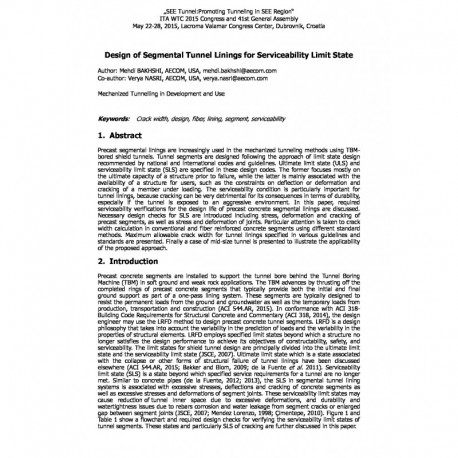Cart
0
0
No document
0,00 €
Total
Document successfully added to your shopping cart
Quantity
Total
There are 0 items in your cart.
There is 1 item in your cart.
Total documents
Total shipping
To be determined
Total
Search & filter
Search for a publication
Search & filter
Viewed documents

Design of Segmental Tunnel Linings for Serviceability Limit State
wtc2015_full_bakhshi
Precast segmental linings are increasingly used in the mechanized tunneling methods using TBM- bored shield tunnels. Tunnel segments are designed following the approach of limit state design recommended by national and international codes and guidelines. Ultimate limit state (ULS) and serviceability limit state (SLS) are specified in these design codes. The former focuses mostly on the ultimate capacity of a structure prior to failure, while the latter is mainly associated with theavailability of a structure for users, such as the constraints on deflection or deformation and cracking of a member under loading. The serviceability condition is particularly important for tunnel linings, because cracking can be very detrimental for its consequences in terms of durability, especially if the tunnel is exposed to an aggressive environment. In this paper, requiredserviceability verifications for the design life of precast concrete segmental linings are discussed. Necessary design checks for SLS are introduced including stress, deformation and cracking of precast segments, as well as stress and deformation of joints. Particular attention is taken to crack width calculation in conventional and fiber reinforced concrete segments using different standard methods. Maximum allowable crack width for tunnel linings specified in various guidelines and standards are presented. Finally a case of mid-size tunnel is presented to illustrate the applicability of the proposed approach.


